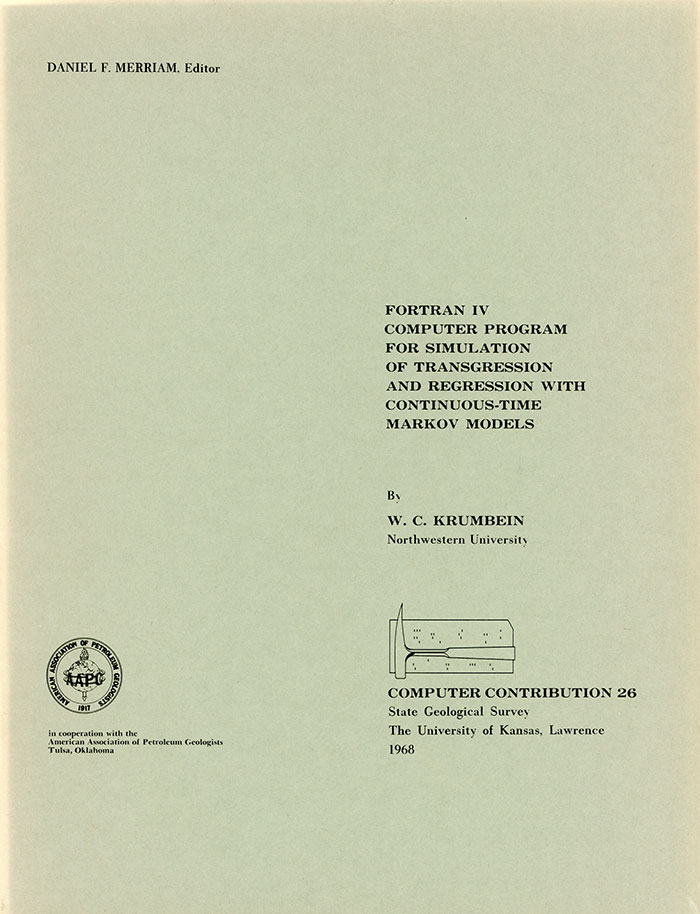
Kansas Geological Survey, Computer Contributions 26, originally published in 1968
Northwestern University

Originally published in 1968 as Kansas Geological Survey Computer Contributions 26.
Continuous-time Markov models based on lateral movement of shallow marine and nonmarine environments during transgression and regression through continuous time can be adapted to a variety of lateral-shift processes, such as progressive facies changes across a sedimentary basin, onlap+offlap relations among stratigraphic rock bodies, etc. In this report a clastic-wedge model is used to generate equally spaced borehole or outcrop sections that show the type of deposits formed as the environments shift back and forth.
The states of the transgressive-regressive system can be defined in terms of the position of the strandline through time, with the accumulating sediments representing responses to particular environments as they successively occupy a given monitoring station. Simulations are performed with a transition-rate matrix instead of the conventional transition-probability matrix, although the latter can also be adapted to lateral-shift processes. These two kinds of matrices can be transformed from one to another, and a computer program for this purpose is listed in this report. The main simulation program is illustrated with an experimental example, and the body of the text discusses some of the implications involved in structuring Markov models as continuous-time, discrete-state mechanisms.
Simulation models for stratigraphic analysis can be structured in a variety of ways to produce sections ranging from completely deterministic sequences to completely random successions of beds. The states of the system can be defined as the lithologic components that make up the strati graph ic body, or they can be defined in terms of the underlying geological process that controls the types and successions of rock types present. Simulation models also can be classified according to their emphasis on the vertical arrangement of beds in a single section, or on lateral relations among adjacent vertical sections, where one or more marker beds are present. In addition to these different ways of defining states and focussing on vertical or lateral relations, simulation models can be structured so that changes of state are controlled by transition probabilities or transition rates.
This paper is concerned with a stochastic simulation model in which the pattern of lithologic succession is examined in terms of the length of time that the system remains in a given state, once it has entered that state. The model is also based on transgressive-regressive motion of a strandline, with the resulting lithologic units developing as responses to the movement of sedimentary environments laterally and through time. A preliminary report on the model used here was published as part of the Kansas Geological Survey's fourth Computer Colloquium (in Merriam and Cocke, 1968, p. 11-21). Some excerpts from the preliminary report are included later for completeness, in part with respect to the development of a stochastic simulation model from a deterministic counterpart.
There is a fairly close relationship between transition probabilities and transition rates, and some implications involved in selecting one or the other for simulation studies are developed. Two computer programs are listed in the Appendix, one for transforming transition probabilities into transition rates, and the other for simulating a transgressive-regressive process.
Computer programs listed in the Appendix are illustrated with a conceptual transgressive-regressive clastic-wedge model, in which transition rates are arbitrarily (though in part realistically) selected to develop sedimentary cycles of varying lateral extent, and with varying duration in time. This example is in the category of "geological experimentation" as advocated by Harbaugh (1966; see also Harbaugh and Merriam, 1968, Chapter 8). In these studies the experimental parameters may be varied to give insight into geological processes that are only partly understood, or into processes for which critical quantitative data may not yet be available.
The topic of using actual stratigraphic data for setting up transition-rate matrices, both for the lateral-shift model and for simulation of single stratigraphic sections, is developed later. Other topics, such as ways to define states, the use of transition probabilities instead of rates in lateral-shift models, and the application of rate matrices to simulation of single stratigraphic sections, also are discussed in the last part of this paper.
I am much indebted to the Geography Branch of the Office of Naval Research for continuing financial support in conducting these studies, and for opportunities extended by Dr. John W. Tukey of Princeton University for me to participate in his Statistical Techniques Research Group during the spring of 1966. Paul Tukey, at that time an undergraduate at Princeton, prepared the basic BOREHOLE program, and devised the "clock mechanism" that allocates the appropriate number of output lines to each state on the basis of the random interval in continuous time that the state is occupied. Dr. L. L. Sloss of Northwestern University gave me the benefit of his wide stratigraphic experience as it relates to time and thickness in stratigraphic columns. Wolfgang Scherer, a graduate student at Northwestern, contributed much time and effort in taking care of computer program details as this manuscript was being written.
Read the PDF version (6.9 MB)
Kansas Geological Survey
Placed on web Sept. 6, 2019; originally published 1968.
Comments to webadmin@kgs.ku.edu
The URL for this page is http://www.kgs.ku.edu/Publications/Bulletins/CC/26/index.html